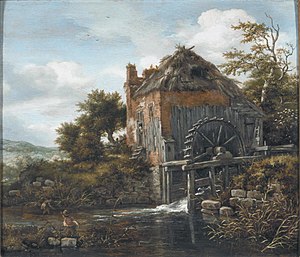Watermill at a farm

|
| Watermill at a farm |
|---|
| Jacob Isaacksz. van Ruisdael , around 1660 |
| oil on wood |
| 37.6 × 44 cm |
| Boijmans Van Beuningen Museum , Rotterdam |
The painting watermill in a farm ( Dutch Watermolen bij een boerenwoning met rietdak , in Ruisdael works by Seymour Slive it bears the title of English Thatch-roofed house with a Water Mill ) is a landscape of the Dutch painter Jacob Isaacksz. van Ruisdael , which was created around 1660. It came into the holdings of the Boijmans Van Beuningen Museum in Rotterdam in 1958 when the industrialist Daniël George van Beuningen's art collection was taken over .
Background and description
The picture has the format 37.6 × 44 cm and is executed using the technique of oil on canvas . It is signed on the lower left with JvR .
Like windmills , water mills were among the frequently depicted motifs by Jacob van Ruisdael. On a trip to the county of Bentheim in western Germany, he had seen numerous such mills and selected them as motifs for his paintings. The mill shown has an undershot wooden mill wheel, the shaft of which is mounted on a block of wood. Two men are cutting reeds in the water . A woman looks out of the door of the building. A hilly landscape is visible on the left edge of the picture. It is not known which real mill Ruisdael served as inspiration or model. It is believed that it could either be a mill in Haaksbergen or one of the mills on the Singraven estate in Dinkelland , which were sold to the Netherlands by the Count of Bentheim in 1651 and were at that time one of the most famous water mills in Twente . That with thatched roofed house is not in good condition, the shuttering boards to protect against moisture generated by the mill wheel is damaged, the roof is not worked carefully. In the back of the building, the brick wall is covered with young birch trees and other plants. The painter took particular care to depict the landscape with its gnarled trees and the underwater of the mill as realistically as possible. This was also noticed by the romantic English landscape painter John Constable , who saw the picture at the London art dealer John Smith and who later published the first Ruisdael catalog of works. Constable held it in high regard and described it in an 1826 letter to his friend John Fisher , the Bishop of Salisbury:
“I have seen an effecting picture […] by Ruisdael. It haunts my mind and clings to my heart - and has stood between me & you […]. It is a watermill, not unlike 'Pernes Mill' - a man & boy are cutting rushes in the runnig stream […] - the whole so true clear & fresh - & as brisk as champagne […] - & showed Ruisdaels compass of mind in landscape. "
“I saw a moving picture of Ruisdael. It sticks in my mind, touches my heart and stands between you and me. It's a watermill, similar to Perne's . A man and a boy cut rushes at the Mühlbach. The whole thing is really as clear and fresh as a breeze in Champagne and shows the spiritual direction in which Ruisdael's landscapes are pointing. "
Perne's Mill is a painting by Constable from 1823. It is in the Fitzwilliam Museum, Cambridge.
Provenance
Not much is known about the provenance of the picture. It is said to have appeared at the art dealer Jacques Goudstikker in Amsterdam in January 1920, and in 1949 to the industrialist and art collector Daniël George van Beuningen (1877–1955) from Rotterdam / Vierhouten, whose estate went to the Boijmans Van Beuningen Museum in Rotterdam in 1958 .
Exhibitions
- January / February 1920: Copenhagen
- June 19 to September 25, 1955: Kunstschatten uit Nederlandse verzamelingen. Boymans Museum, Rotterdam
- January 7th to May 28th 2007: Meesters en molens. Van Rembrandt dead Mondriaan. Noordbrabants Museum, 's-Hertogenbosch; Museum Bredius, 's-Gravenhage; Drents Museum, Assen
Web link
- Water mill near a farm, c. 1660. on the website of the Museum Boijmans van Beuningen, Rotterdam (the Dutch description on the page is more extensive than the English one)
Individual evidence
- ↑ a b c Watermolen bij een boerenwoning met rietdak, circa 1660. on boijmans.nl (Dutch).
- ^ RB Beckett (Ed.): John Constablde's Correspondence. Volume VI: The Fishers. Ipswich 1968, p. 229.
- ^ Seymour Slive: Jacob van Ruisdael - Master of Landscape. Yale University Press, 2006, ISBN 1-903973-74-0 , pp. 32 f.
- ^ Graham Reynolds, John Constable: Constable's England. Metropolitan Museum of Art, New York 1983, ISBN 0-87099-335-6 , pp. 94/95, ( books.google.com ).
- ↑ John Constable at Gillingham. Gilligham Museum website in Dorset.
- ↑ Gillingham Mill, Dorset. at collections.vam.ac.uk ( Perne's Mill ).
- ↑ Charles Dumas, Leo Endedijk, Leo van der Drift: Meesters en molens. Van Rembrandt dead Mondriaan. Waanders, Zwolle 2007, ISBN 978-90-400-8291-7 .